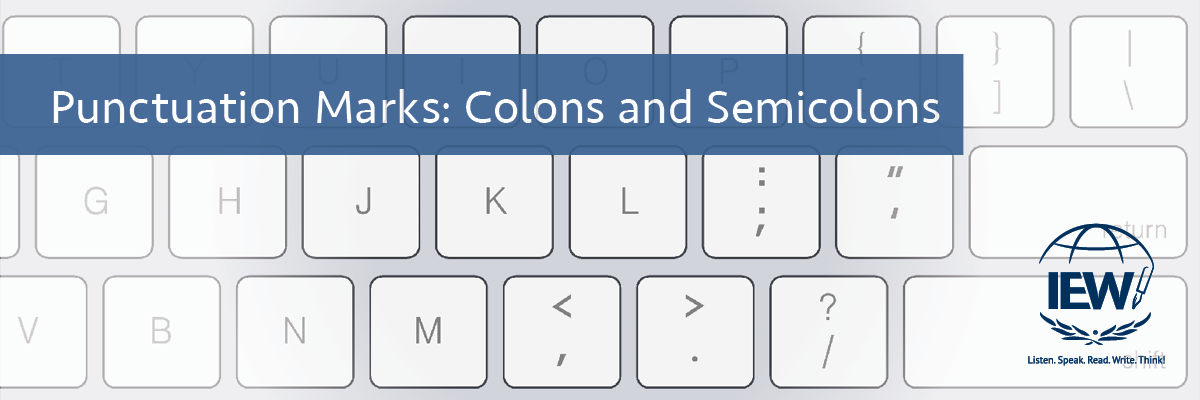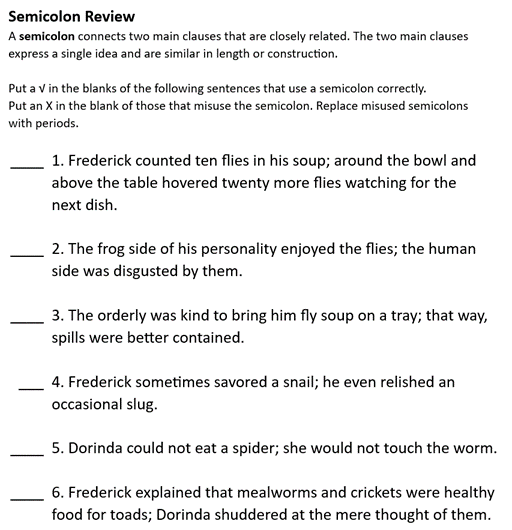
Look closely at the title. Why is there a colon? How does a colon differ from a semicolon?
Fix It! Grammar has the answers, and students who use the grammar program will not only know the answers but have plenty of opportunities to practice using these punctuation marks. Misuse of a colon or semicolon may not be as deadly as misuse of a comma as explained in “Punctuation Matters,” but it is worth a look.
Before one can fully understand the explanation and rules behind colons and semicolons, there must be an understanding and practice of previous grammar skills such as clauses, phrases, conjunctions, and conjunctive adverbs. Therefore, colons and semicolons are not covered until Fix It! Grammar Levels 5 and 6.
A semicolon is the punctuation symbol with a dot at the top and a comma at the bottom. The younger generation may know the symbol as the eyes in the winky face ;-) However, it does serve a grammatical purpose, especially in academic papers.
Should you use a semicolon to separate two clauses; should you use it to separate two phrases? You should use it only with one of these: clauses. A semicolon connects two main (independent) clauses that are closely related. Often it can be used to fix a run-on sentence, but it should be used sparingly. If a semicolon is used, the two main clauses must express a single idea. The semicolon tells the reader that you understand these are two main clauses, but the content is so closely related that the main clauses really belong together. Semicolons are best used when the clauses are similar in length or construction.
Fix It! Grammar: Level 5 has a review page devoted to semicolons. Can you do it? See the end of this article for the answers.*

A colon is the punctuation symbol with two dots stacked on top of each other. It can be found above the semicolon next to the “L” on most keyboards. The colon appears in titles to separate elements. It is most commonly used between titles and subtitles. Take a look at any podcast episode for a practical example.
In sentences a main clause (MC) must precede the colon. The text that follows the colon further explains the clause. What comes after the colon will end the sentence. Here are a few patterns:
MC: list.
MC: explanation.
MC: Quotation.
Colons are used most often for lists. Be careful, though; a main clause must make complete sense. The first two examples that follow are incorrect.
I must: x, y, z.
“I must” does not express a complete thought and cannot stand as a main clause before the colon. The colon in this sentence is incorrect.
My to-do list today includes: x, y, z.
“My to-do list today includes” does not express a complete thought and cannot stand as a main clause before the colon. The colon in this sentence is incorrect.
My to-do list today includes x, y, and z.
This is correct with no colon and the end mark. It is a sentence.
My to-do list today includes three things: x, y, and z.
This is correct with the colon because “My to-do list today includes three things” expresses a complete thought that can stand alone as the main clause before the colon.
For a quick reference regarding these two punctuation marks and much more, consider using Portable Walls Grammar on the Go or Fix It! Grammar Cards.
*Sentences 2, 4, and 5 correctly use the semicolon.
